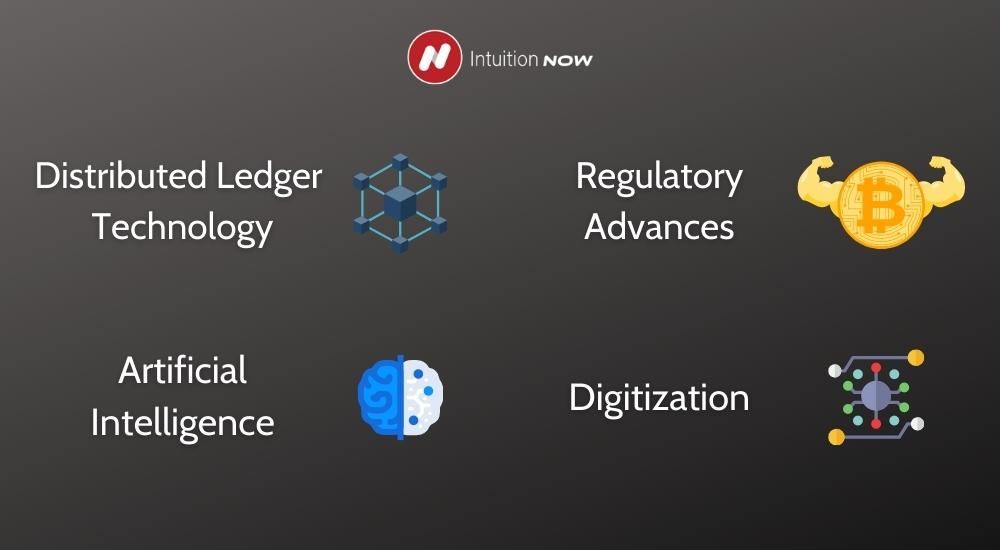With the world entering 2022 and in a continuing battle with the ever-evolving COVID-19, witnessing surging inflation globally, and with central banks tapering QE and even hiking rates in some emerging market countries, we look at the trends and innovations in finance we expect to see in the year ahead.
These trends are led by:
- Distributed ledger technology (DLT)
- Artificial Intelligence and Machine Learning
- Regulatory Advances
- Digitization
In fact, it’s expected that the FinTech market will reach a market value of $309.98 billion, more than twice its 2018 value of $127.66.
This article goes through these areas of disruption in the financial services industry.

While the media focuses on the latest cryptocurrency trends, real value lies within the latest distributed ledger technology (DLT).
DLT enables businesses to transact directly and in strict privacy using smart contracts, reducing transaction and record-keeping costs while streamlining business operations.
Related article: Crypto, Blockchain, and Crypto Assets 101
It enables transaction certainty, increased security, scalability, and appropriate controls.
This is already used in banking and finance for information sharing (e.g. R3’s KYC and Interbank Information Network on Quorum), securities and derivatives clearing, processing and settlement (We.Trade on IBM’s Hyperledger, VAKT on Quorum and Axoni for equity swaps), trade finance and supply chain (eTradeConnect and Tradelens on IBM’s blockchain platform using Hyperledger Fabric), secondary market trading, central bank digital currencies, venture capital and cross border payment systems.
In 2022 we can expect to see more assets given digital identities to reduce confirmation and settlement times, from the standard two days for bonds, CDs, commercial paper etc to near real time, also reducing the need for third party warehousing and the tie-up of transacting parties' balance sheet.
Related article: Understanding Cryptocurrencies – The Importance of Financial Literacy for the Part-Time Investor Ethereum completed $1.5 trillion dollars of transaction in Q1 2021, and with layer 2.0 to be delivered soon, expect volumes to increase and new leaders such as Cardano, Polkadot and Solana to emerge.
Meanwhile, the largest cryptocurrencies are trading with increased correlation to the U.S. Nasdaq.
Previously they were seen as an alternative investment clasUnderstanding Cryptocurrencies – The Importance of Financial Literacy for the Part-Time Investors but with institutional investment in crypto increasing, the correlation is undeniable.

Artificial intelligence (AI - solving and automating tasks) and machine learning (ML - identifying trends from large sets of data) will continue to develop better customer experiences, automate back end processes, manage credit risks, reduce fraud, forecast economic trends, automate trading, and optimize machine and device performance. In fact, we can also expect far greater interaction with chat bots in the year ahead.
One risk with AI and machine learning however is concentration risk in financial markets.
Unbelievably, in the last 12 months more money ($1.1 trillion) has flowed into equities than the previous 19 years combined (BofA Global research).
As inflation rises and central banks reduce their monetary stimulus programs, any sell-off inequities could see massive deleveraging from algorithms that dominate daily transaction flows.

2022 could be the year of more intense regulation.
Firstly, regarding the tech giants and big data.
Secondly across the crypto marketplace.
And thirdly, to combat ESG greenwashing.
Related article: What is ESG Investing?Financial fraud is rife among offshore exchanges lacking in know-your-client (KYC), terrorism financing, and anti-money laundering checks.
Stable coins have also been identified to have made false claims about their actual asset backing, and crypto exchanges host unethical practices that are illegal in other asset classes.
Gary Gensler and the SEC are on the front foot, and while regulatory authority and enforced audits (stablecoins) may harm crypto prices and stable coins in the short term, it will bring greater clarity and transparency to the market in the long run.

According to Statista there are 6.37 billion cell phones on the planet, up from 3.6 billion in 2016.
This enables increased digitization across the planet as we continue to move away from branch banking towards contactless payment, digital banking (over 50% of millennials with a bank account have never been in a bank branch), digital signatures, and AI-based lending approvals.
Digitization also enables greater access to education, a massive threat to the established university/college system as degrees and diplomas can be completed on-line using educational resources.

One thing is for sure - 2022 will see increased competition in finance with more emerging FinTech start-ups competing against the established banking giants.
Whether it be digital banking (Monzo, Oaknorth, NU Bank, Fidor), Robo advisors (Betterment, Nutmeg, Kantana, Motif), FX transactions (Revolut, TransferWise, HiFX, Currencies Direct), capital raising and crowd funding (CircleUp, SwissCom, Cinch, C2FO) structure products (Vontobel, FinIQ, Leonteq, Contineo), payments, InsureTech, lending, remittances, regtech and so on, the financial marketplace and technologies will continue to evolve at a rapid pace.







